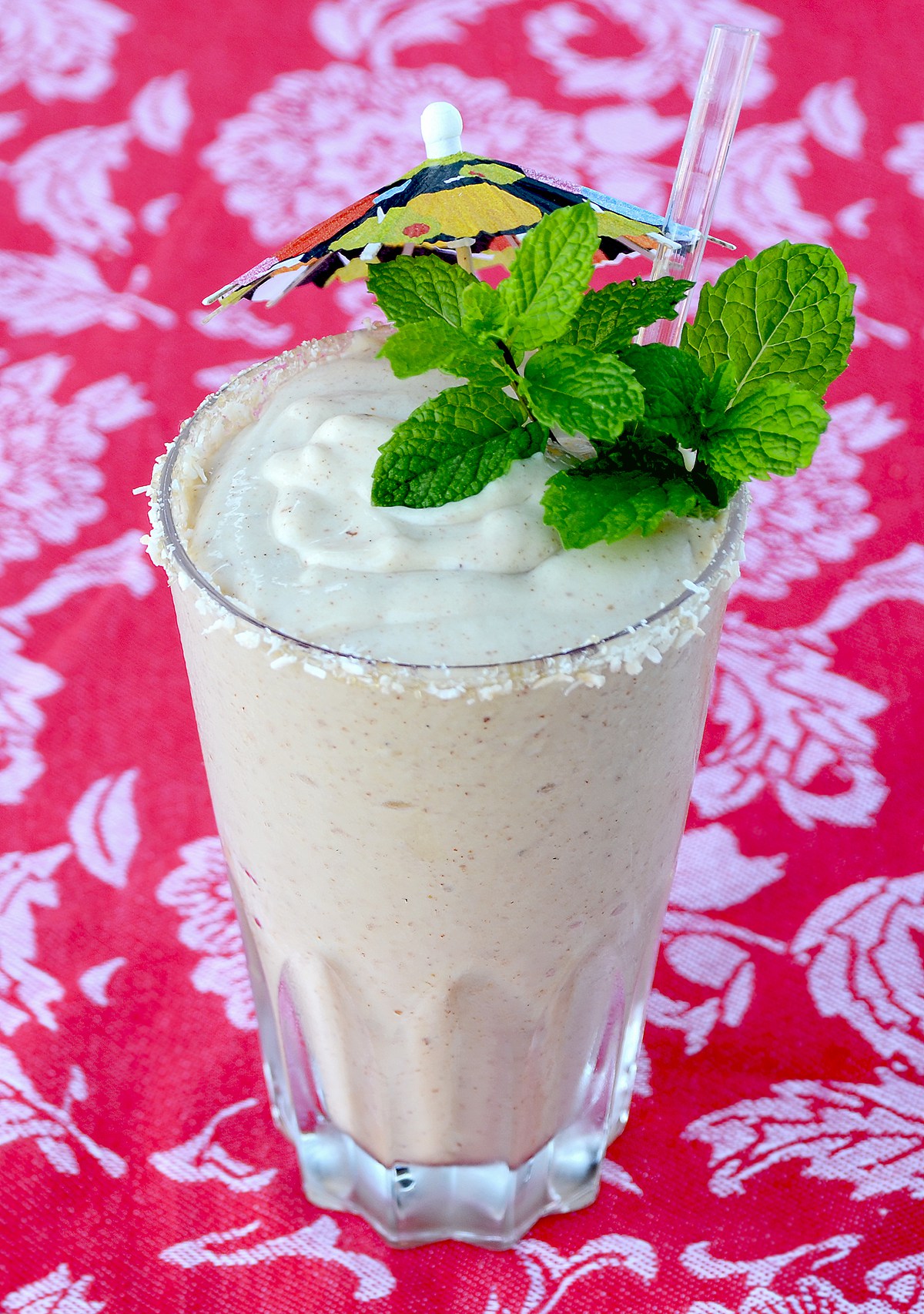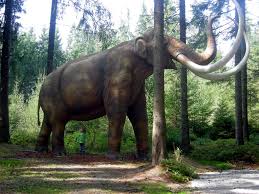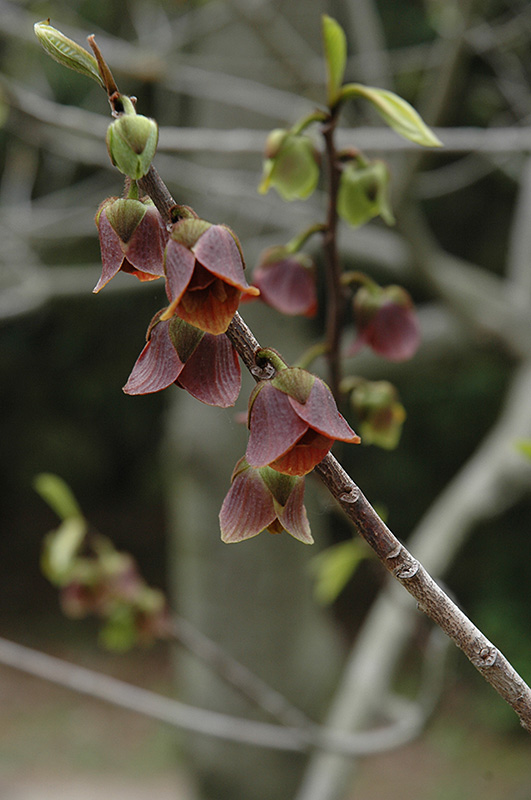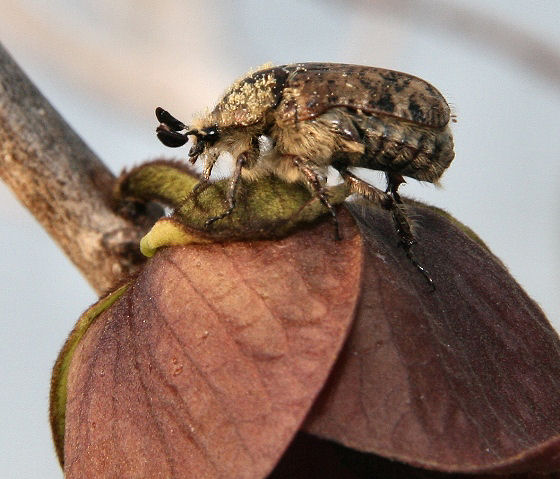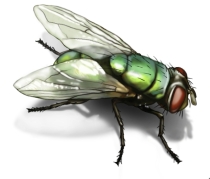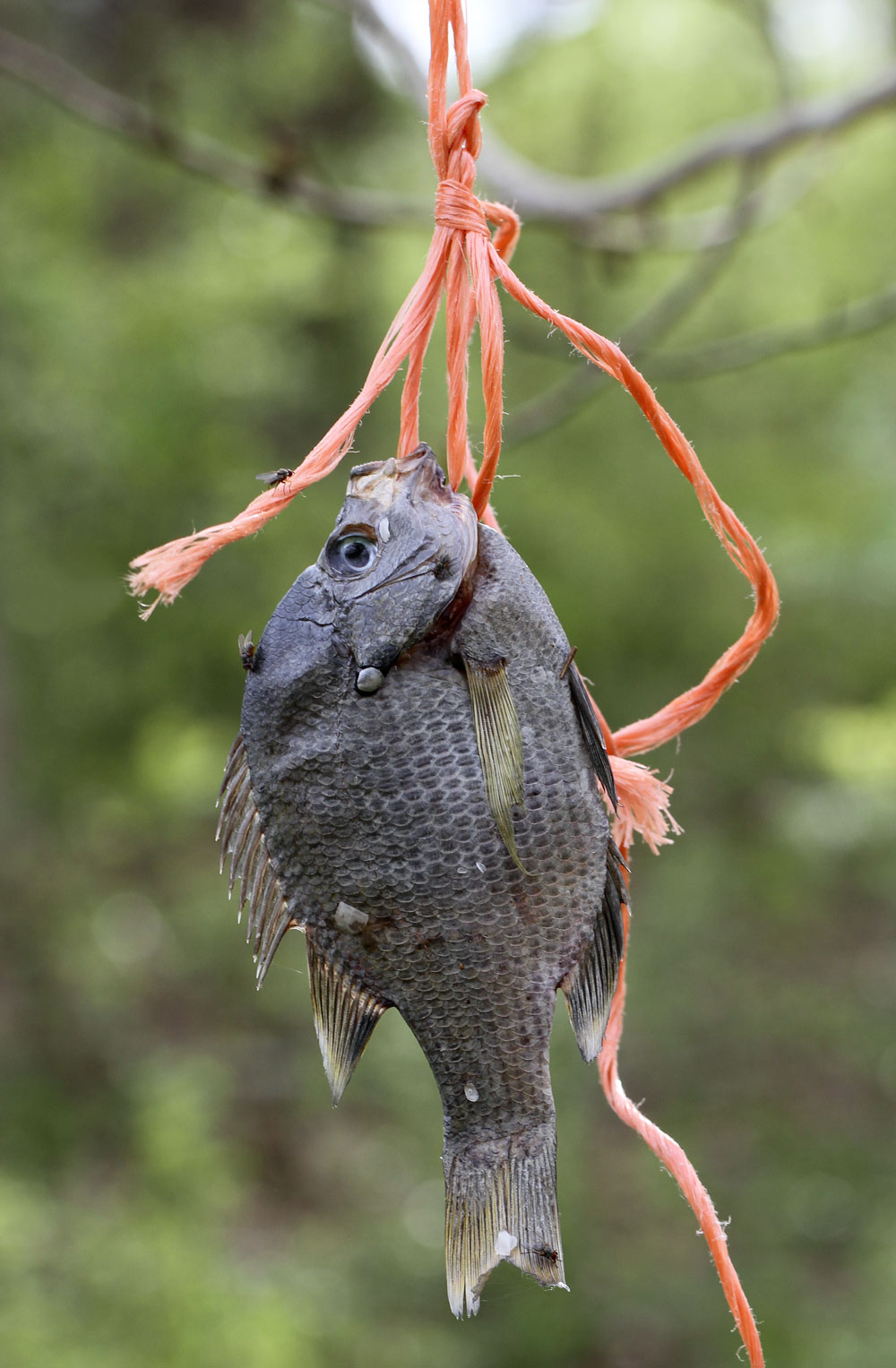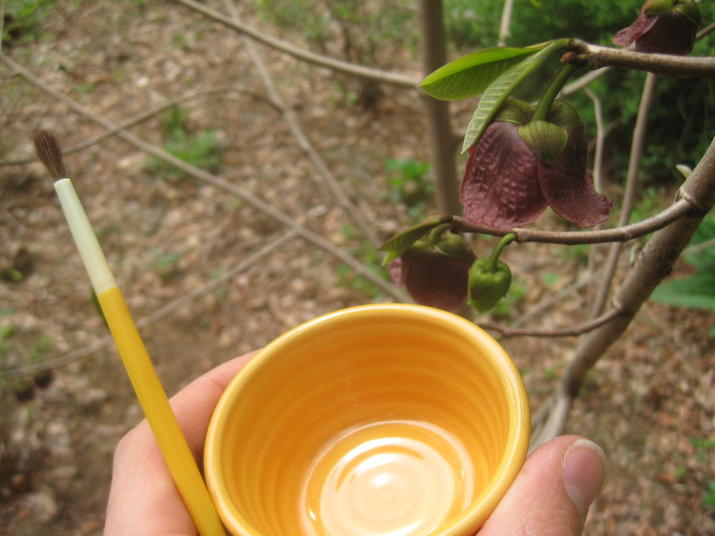by Tom Gibson
Growing pawpaws and, especially, getting them to fruit in quantity has been an exercise in slow motion frustration. Each year since my 6 trees started flowering in 2010 (planted in 2008) I’ve made at least one misstep that has limited production and/or harvest.
It reminds me of a particularly agonizing game of baseball, with just one or two swings per year and never getting the bat squarely on the ball. What follows is an account of my ups (few) and downs (many) as I try to raise a proper harvest and how (spoiler alert!) this year I may finally have hit a home run.
A good pawpaw crop is a worthy goal. The fruit are delicious—with a taste somewhere between a banana and a mango. They are great fresh from the tree , in smoothies , and in a whole range of desserts.
They also contain exceptionally high levels of nutrition. (http://www.pawpaw.kysu.edu/pawpaw/cooking.htm)
They are native to North America (with custard apple relatives in Central America) and they are particularly resistant to many of the plagues of more traditional fruit, from fungi to insects to deer. (Their leaves even contain compounds that are the basis for insecticides.) Their history is particularly ancient; at one time they enjoyed a symbiotic relationship with mammoths
(https://www.americanforests.org/magazine/article/trees-that-miss-the-mammoths/), who ate the fruit, pooped out the seeds in a nice pile of fertilizer, and spread the trees far and wide. In recent years, pawpaws and their consumers have benefitted from active breeding for flavor.
But they still have distinct idiosyncrasies that reflect their origins. And it’s those idiosyncrasies with which I have struggled over the past 6 years since my pawpaw trees started to flower. Here’s my chronicle:
Year 3, 2010. I had already avoided the problem of cross-pollination by planting two distinct cultivars. In this, I was better off than the Holden Arboretum, which planted only one set of cultivars and was puzzled when they didn’t fruit! A huge, embarrassing swing and a miss!
But my pawpaws still weren’t fruiting. Their pre-Columbian origins meant that they had evolved without the honey bee. Thus the pawpaws’ dark red, funereal l flowers that don’t look or smell like anything a bee would visit.
Instead, its pollinators are detritus-loving beetles and blow flies, the iridescent blue-green flies we see on dog poop.
Clearly, my suburban Cleveland Heights yard did not contain enough dead animal waste!
Some pawpaw growers solve this problem by supplying their orchards with roadkill and dead fish
(definitely not an approach that would have pleased my neighbors or my wife!).
An Athens, Ohio, permaculturist runs goats through his pawpaw orchards. The goats eat grass that might compete with the pawpaws and leave behind poop. The ingenious farmer harvests both milk and fruit. But, once again, not a Cleveland Heights solution.
So flowers, but no fruit. In baseball terms, a called strike.
Year 4, Spring 2012. The suggested online solution for suburban pawpaw pollination is by hand. Buy the finest-haired, most delicate water color brush and gently knock pollen off one cultivar’s flower into a dish, then “paint” the pollen into the flower of another cultivar.
I try this, bumbling around inside one flower, knocking loose a light brown shower of particles, gathering the pollen on my brush, and bumbling around again inside the next cultivar’s flower. I have no idea if I’m hitting the stigma, the female part of the flower, but then, in a meta sense, blow flies don’t know what they’re doing, either.
Year 4, Fall 2012. Twenty fruit have formed! Green orbs the size of mangos. 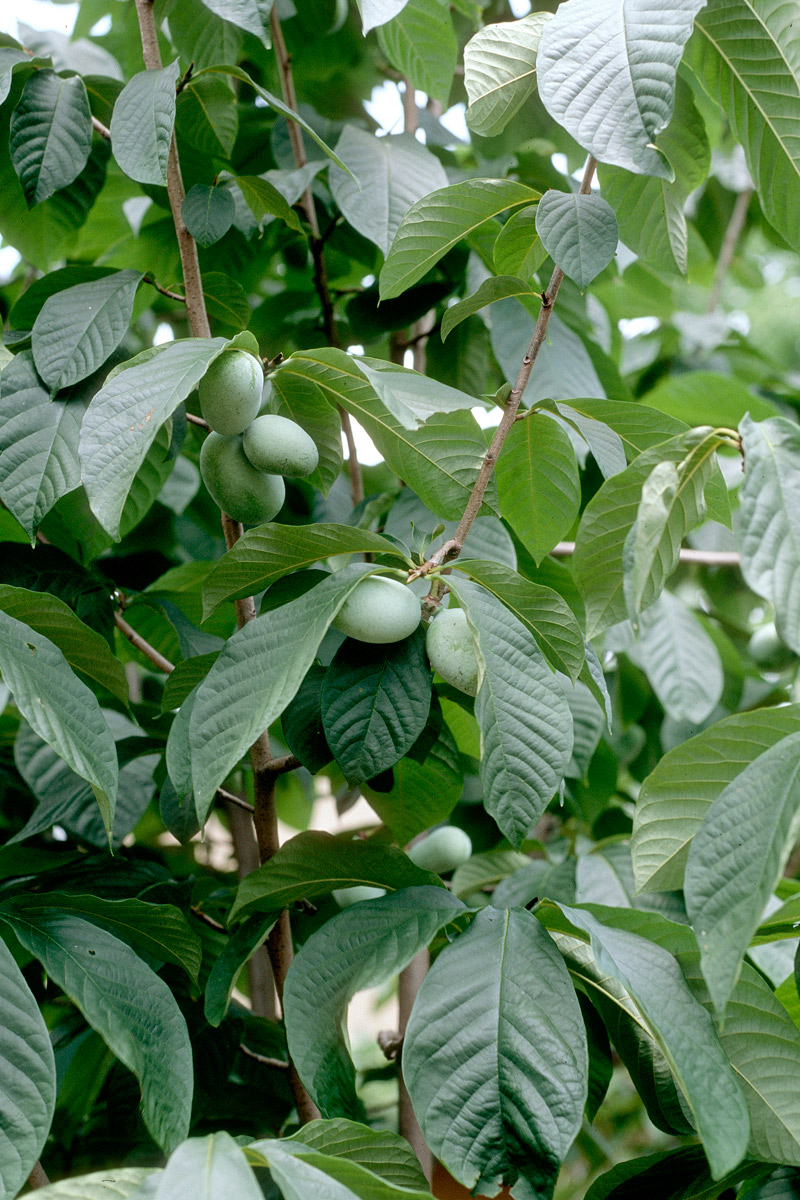
A Wooster Arboretum horticulturist tells me to wait until the pawpaws turn brown before harvesting. So I wait. It’s early October, but still no brown, maybe a tiny suggestion of yellow. Suddenly 4 of the fruit on one cultivar disappear. It looks like a raccoon or a possum knew more about pawpaw ripeness than my horticulturist acquaintance.
I learn to judge ripeness by feel. Just the right amount of softness and I can bring fruit from the other, later-maturing cultivar into the kitchen window sill for raccoon-free ripening (too early, though, and the fruit never gets ripe enough to eat!).
Nevertheless, my wife and I are excited. We love the wonderful custardy texture of a fully ripe pawpaw. We give a few fruit away to special gardening friends. It’s almost like child birth. I tell my grandchildren that I have become a “Pawpaw Papa!”
Of all our progeny, we managed to harvest and eat just 12 of the original 20. In baseball terms, we’ve gotten hits, but we’ve left a lot of runners on base. We want to score more!
Years 5 and 6, 2013-2014. More fruit, require more blossoms. But the latter seem less abundant they should be. Eric Toensmeier, the famous permaculturist, who grows pawpaws prolifically in Massachusetts, writes that, in nature, pawpaws like to grow as understory trees next to black locusts. Presumably, pawpaws crave the nitrogen that these legume trees and their symbiotic bacteria make available to the plants around them. Elsa Johnson, my landscape design partner and Gardenopolis Cleveland co-editor, and I get permission from the Cleveland Museum of Natural History and travel to the museum’s Ashtabula preserve where black locusts grow like weeds. We dig up five foot-high seedlings and transplant them right behind my pawpaw trees. Just a few years later and the black locusts are taller than the 12 foot pawpaws.
I also spread a wood chip mulch around the trees—both to preserve moisture (noting that pawpaws often grow in the wild along river banks) and proliferate root growth.
Finally, I add lime, since calcium is supposed to aid fruit set.
Harvests stay in the 15 to 20 fruit range. We’re winning, but not by much.
Year 7, 2015. Whatever we’ve done seems to have worked. Blossoms appear in profusion. I hand-pollinate furiously for 10 days. After a week or so, tiny fruitlets appear—200 in all! (You’re probably beginning to notice a certain obsessiveness on my part!). Then, disaster! Two strong thunderstorms knock all but 4 fruitlets off the trees. My grand slam home run as essentially turned into a long out.
Later that fall, I notice that most of the lime was still in place, still undissolved. So not much help for fruit set. Instead, I learned in last fall’s Ohio State Soil Fertility course (http://www.gardenopoliscleveland.org/2015/12/four-permaculture-insights-from-a-soil-fertility-course/) that gypsum or calcium sulfate should have been my preferred source of calcium. Not only do the calcium ions in gypsum dissolve rapidly, but gypsum does not raise the pH. (Pawpaws prefer a more acidic pH of 5.5 to 7.) I spread gypsum under every tree.
Year 8, 2016 spring. So here we are. What do we have? Despite 4 vigorous thunderstorms this spring, the fruit have held. I’ve got about 20 adolescent fruit per tree and they’re looking great! Will 2016 be the Year of the Big Score? I’ll let you know in October.
